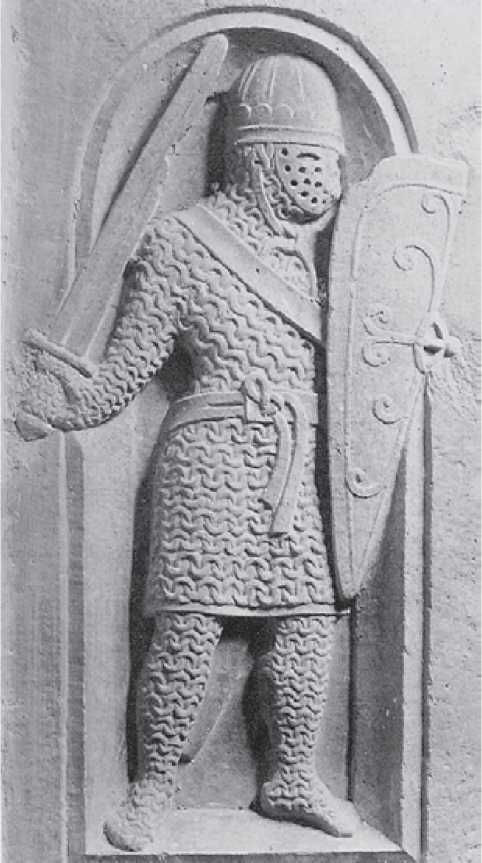
Amazon Audible Gift Memberships
Relief of a Knight, Basilica di Santa Giustina, Padua, Italy, c.1190-1210AD.

Image source: historylib


Siamo nella Basilica di Santa Giustina che, nell’atrio della Sagrestia, conserva poche ma preziose decorazioni risalenti al periodo romanico dell’edificio.
La nostra attenzione viene attirata dai resti di un portale ornato da bassorilievi realizzati probabilmente da maestri francesi. In una colonnina a sinistra del portale, una formella racchiude una raffigurazione di un guerriero in armatura del XII secolo.
Qui possiamo ammirare, invece, la dettagliata riproduzione di un usbergo, un’armatura composta da anelli di ferro che proprio tra XII e XIII secolo raggiungeva l’apogeo della sua evoluzione.
I particolari
Quello che rende unico e prezioso questo bassorilievo sono i particolari.
Si distingue nettamente la cintura alla vita, così come il cinturino dell’elmo e la bretella che regge lo scudo; si nota poi, all’altezza delle ginocchia, l’orlo della veste indossata sotto l’armatura. L’assenza di speroni e di uno spacco centrale nell’usbergo fanno pensare che il nostro guerriero potesse essere più probabilmente un fante o perlomeno un cavaliere che non combatteva a cavallo. Il fodero, che si intravede tra le gambe, ci fa capire che la spada veniva portata alla cintura sul lato sinistro.
Altro particolare di rilievo è il guanto a manopola che impugna la spada tipico dei secoli XII e XIII.
La forma della spada, a doppio filo, piatta, larga e con punta arrotondata, ci dice che veniva usata soprattutto per colpire mediante fendenti.
Il dettaglio più interessante dell’armatura rimane comunque l’elmo. Il coppo, apparentemente diviso in spicchi, è costituito in realtà da una sola lamina lavorata a cannellini verticali che conferiscono rigidità e resistenza alla struttura. La stessa funzione ha la coroncina a semicerchi che cinge tutta la testa. La vera peculiarità di questo elmo è, però, la maschera che raramente si trova in raffigurazioni artistiche. Prototipo dell’elmo completo di forma cilindrica che dominerà i campi di battaglia per tutto il XIII secolo, nascondeva completamente la testa conferendo al cavaliere un aspetto austero ed alieno.
Source: Un cavaliere in sagrestia by Fabio Dalla Cia 2020.
We are in the Basilica of Santa Giustina which, in the atrium of the Sacristy, retains a few but precious decorations dating back to the Romanesque period of the building.
Our attention is drawn to the remains of a portal decorated with bas-reliefs probably made by French masters. In a small column to the left of the portal, a panel contains a depiction of a warrior in armour from the 12th century.
Here we can admire the detailed reproduction of a hauberk, an armour made up of iron rings that reached the apogee of its evolution precisely between the 12th and 13th centuries.
The details
What makes this bas-relief unique and precious are the details.
The belt at the waist is clearly distinguished, as is the helmet strap and the shoulder strap that holds the shield; then, at the height of the knees, the hem of the robe worn under the armour can be seen. The absence of spurs and a central split in the hauberk suggest that our warrior could more likely be an infantryman or at least a knight who did not fight on horseback. The scabbard, which can be seen between the legs, makes us understand that the sword was worn on the belt on the left side.
Another important detail is the gauntlet that holds the sword typical of the 12th and 13th centuries.
The shape of the sword, double-edged, flat, wide and with a rounded tip, tells us that it was mainly used to strike by slashing.
However, the most interesting detail of the armour remains the helmet. The bowl, apparently divided into segments, is actually made up of a single sheet worked with vertical channels which give rigidity and resistance to the structure. The semicircular crown that surrounds the whole head has the same function. The real peculiarity of this helmet is, however, the mask that is rarely found in artistic representations. Prototype of the complete cylindrical helmet that will dominate the battlefields throughout the thirteenth century, which completely hid the head, giving the knight an austere and alien appearance.
Fabio Dalla Cia
Referenced on p.176, Arms and Armour of the Crusading Era, 1050-1350, Western Europe and the Crusader States by David Nicolle
439A-B Jungfrauenspiegel, Germany, c.1200
(Kestner Museum, Hannover, Germany)
Comparable and presumably typically-German equipment appears in the similarly-dated Jungfrauenspiegel. It is also shown in greater detail. Again the warriors wear early forms of great helm with rounded edges and not much protection for the back of the neck. One example has a single eye-slit (A), while the second has a vertical reinforcing piece up the centre of the face-mask (B). The warriors carry large, curved, kite-shaped shields on guiges, and wear presumed mail hauberks with mittens, plus chausses. The swords are typical of the time and place.